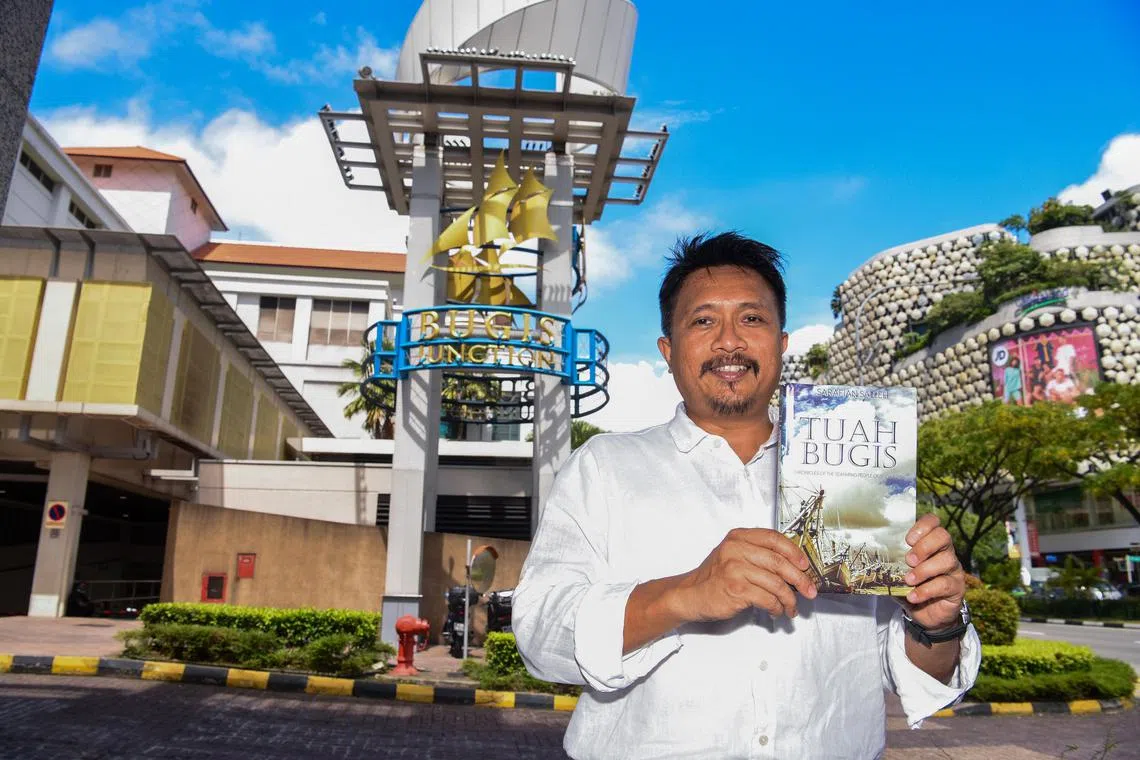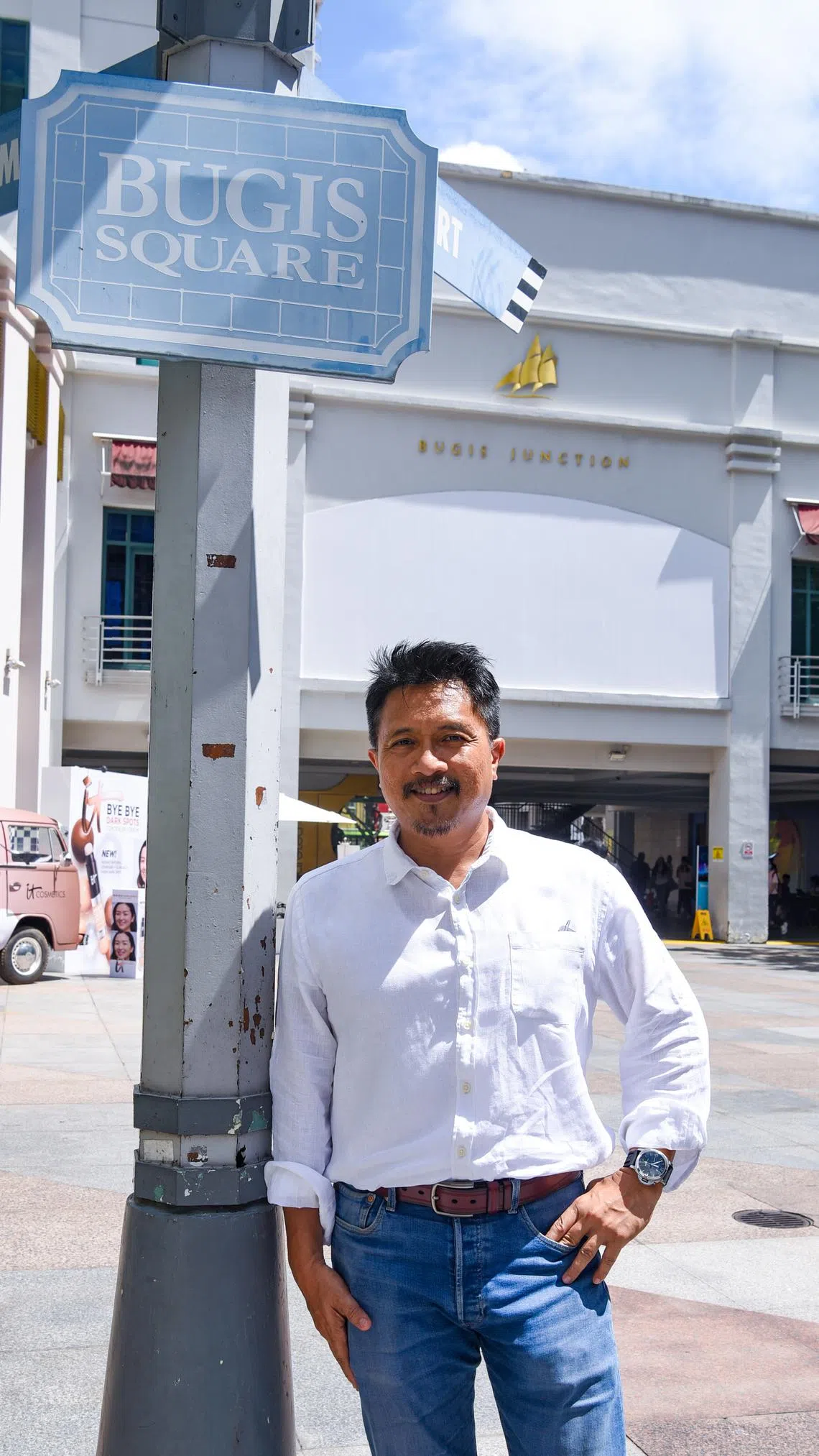Rediscovering Singapore’s Bugis community through a new book
Sign up now: Get ST's newsletters delivered to your inbox

Mr Sarafian Salleh, author of the book Tuah Bugis - Chronicles Of The Seafaring People Of Singapore, at Bugis Junction on Aug 4, 2023.
ST PHOTO: EUGENE TAN
Follow topic:
SINGAPORE - A model of a trading ship in Victoria Street, just outside Bugis Junction mall, is an endearing reminder for engineering consultant Sarafian Salleh of his roots.
The ship, known as the pinisi, pays homage to the seafaring Bugis community in the area in the 19th century.
While there are several places in Singapore named after the Bugis – including Bugis Street, Bugis Junction, Bugis Village and Bugis MRT station – the ship is one of the few physical reminders of their contributions to Singapore, Mr Sarafian said.
“Only a few Singaporeans are aware of who the Bugis were as a people, an ethnic identity and a culture,” he said. “Fewer still would know the Bugis were master seafarers from Sulawesi.”
To educate people here about the community, the 53-year-old Singaporean, who is also a heritage researcher, decided to write an English-language book, Tuah Bugis – Chronicles Of The Seafaring People Of Singapore, which traces the history of a hardy, seafaring people from Sulawesi in Indonesia.
The Bugis in Singapore are now largely assimilated into the Malay community here, but they still have their unique culture and heritage, such as their traditional costume the Sarong Bugis, the Bugis language, and food like coto makassar, a beef soup.
Mr Sarafian estimates that there are currently 4,000 Bugis people in Singapore, including personalities such as Singapore Idol winner Hady Mirza.
In the past, Bugis traders played a significant role in the regional trade networks connecting various parts of South-east Asia.
They started coming to Singapore in droves shortly after the British arrived in 1819, drawn by the promise of more trade. They invested in land and set up a Bugis town here that stretched from Kampong Glam to the Rochor River.
By 1824, there were some 1,851 Bugis in Singapore, making up slightly more than 10 per cent of the population.
Carried by monsoon winds, Bugis ships would come in the hundreds from July to November, bringing with them coffee, sandalwood, tortoiseshell, nutmeg, camphor, frankincense and cotton in exchange for goods like tin and linen.
They were involved in shipbuilding and repair and were known for their fast and sturdy ships, such as the pinisi.
Mr Sarafian’s book, which is supported by the Genealogy Society Singapore (GSS), was a labour of love spanning 15 years. It took time for him to convince the Bugis community to share their personal stories for the book.
“After several years of engagement with the community, these families realised the benefits of sharing their stories because it accumulated knowledge of local heritage and promoted family ties,” he said. “When somebody puts these stories together, they progressively complete the social fabric of our nation.”
After meeting them at heritage walks and public lectures, friendships were forged, trust was gained and the stories flowed.
Mr Sarafian, the current president of the Bugis Malay Society (Singapore), has been organising heritage walks since 2013 and giving public lectures on the Bugis heritage.
He curated the Bugis exhibition organised by the Malay Heritage Centre in 2017 and co-founded Facebook group Bugis Temasek in 2008, which has over 4,000 members now.
The book strives to engage readers with the Bugis’ tales of intrigue and adventure spanning several centuries and their contributions to the development of Singapore.

Mr Sarafian estimates there are about 4,000 Bugis people in Singapore.
ST PHOTO: EUGENE TAN
Mr Sarafian plans to translate the 270-page book into Malay for readers in the region.
GSS president Ng Yew Kang said the book will foster intercultural understanding and appreciation for heritage conservation.
“It’s a story that will resonate with many Singaporeans whose immigrant forefathers arrived from different lands as sojourners but established roots and eventually built a nation,” said the 83-year-old.
The book is available for purchase from the Genealogy Society Singapore, or via http://bugistemasek.blogspot.com mysgheritage@gmail.com
The pre-order price including goods and services tax is $35.
The book will retail at $38 (including GST) after the launch on Sunday.

